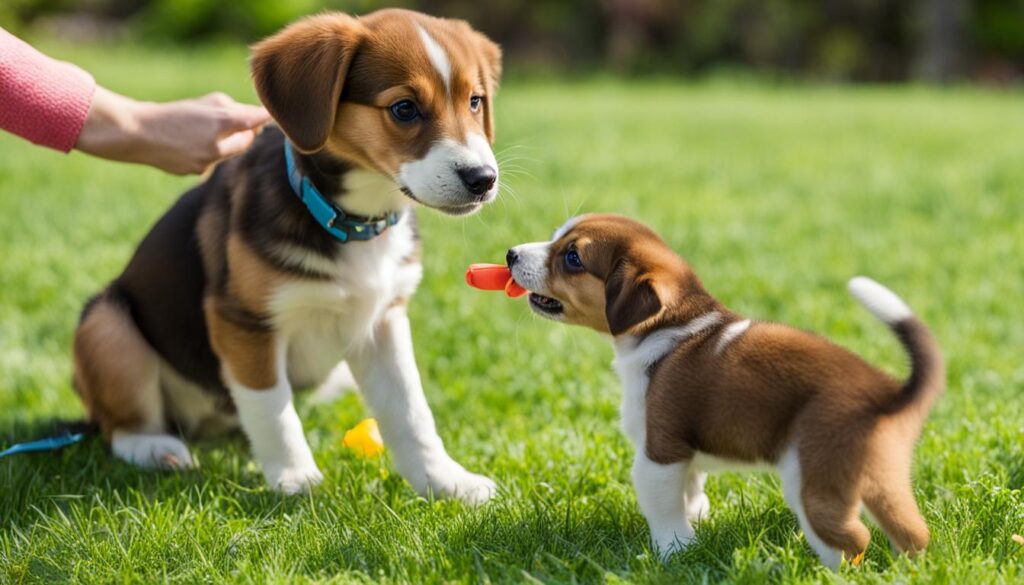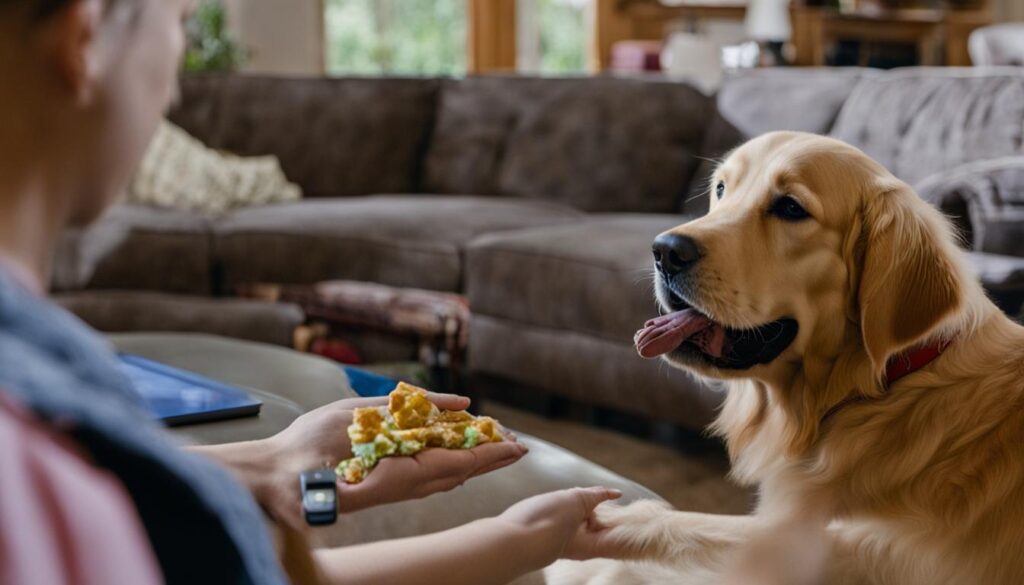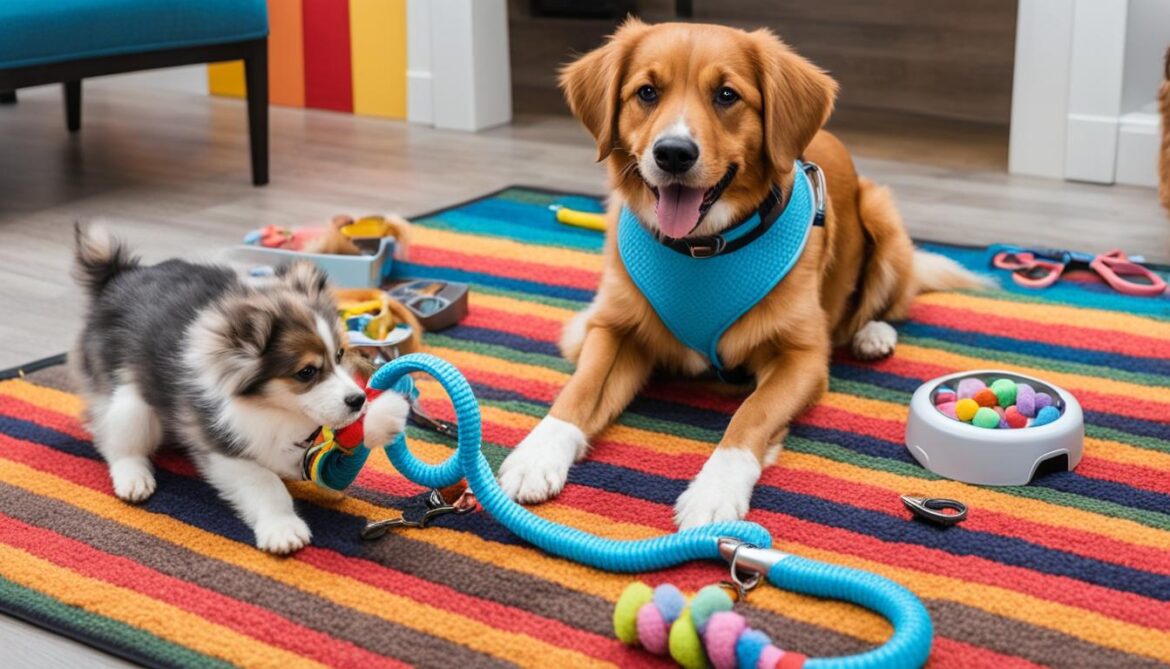Training a dog can be a rewarding experience. However, it requires patience, effort, and consistency to succeed. Professional dog training can be expensive, which is why at-home training is an excellent alternative to consider.
In this section, we will provide you with essential dog training tips to help you train your furry friend successfully. You will learn valuable techniques, such as positive reinforcement, leash training, and house training, among others.
Key Takeaways:
- At-home dog training requires patience, consistency, and effort.
- Professional dog training can be expensive; consider at-home training as an alternative.
- The use of positive reinforcement can help improve your dog’s behavior.
- Leash and house training are essential skills for your dog’s proper behavior.
- With the proper tips and pointers, you can successfully train your dog at home.
Understanding the Basics of Dog Training
Training your dog is an important part of being a responsible pet owner. It’s essential to understand the basics of obedience training before diving into specific techniques. Obedience training teaches your dog essential commands and helps to build a strong foundation for good behavior. The best dog training methods utilize positive reinforcement, rewarding your dog for good behavior rather than punishing them for bad behavior.
When getting started, keep in mind that consistency is key. Training sessions should be short and frequent, focusing on one command or behavior at a time. Always use the same language and hand signals for each command, and reward your dog immediately when they demonstrate the desired behavior.
“The best way to train your dog is through love, patience, and positive reinforcement.”
Another important aspect of dog training is understanding your pet’s behavior and body language. Dogs communicate through barks, whines, and body posture, and it’s important to be able to recognize their signals to address any issues that may arise.
Overall, obedience training for dogs is a crucial aspect of pet ownership. By understanding the basics and utilizing positive reinforcement, you can set your furry friend up for success and strengthen the bond between you.
Essential Puppy Training Techniques
Puppies are adorable, but they can also be a handful – that’s why it’s important to start training them early! With the right techniques, you can shape your pup’s behavior and set them up for success as they grow into adulthood. Here are some essential puppy training techniques to get you started:
1. Positive Reinforcement
Positive reinforcement is the most effective way to train your puppy. This technique involves rewarding good behavior with treats, praise, or toys. For example, if your puppy sits on command, give them a treat and lots of praise. This will reinforce the behavior and encourage them to do it again in the future.
2. Clicker Training
Clicker training is another popular method for teaching puppies new behaviors. The technique involves using a clicker and treats to reward good behavior. For example, if your puppy stays in a designated spot on command, click the clicker and give them a treat. Over time, they will associate the click with good behavior and will be more likely to repeat the action.

3. Consistency
Consistency is key when it comes to puppy training. Make sure everyone in your household is using the same commands and rewarding good behavior in the same way. This will help your puppy understand what is expected of them and make training more effective.
4. Socialization
Socialization is important for puppies – it helps them learn to interact with other dogs and people in a positive way. Make sure to expose your puppy to new situations, people, and dogs in a safe and controlled environment. This will help them develop good social skills and reduce the risk of behavior problems in the future.
5. Patience
Puppy training can be frustrating at times, but it’s important to be patient. Remember that puppies are still learning and may need time to understand what is expected of them. Stay calm and consistent, and reward good behavior whenever possible. With time and patience, your puppy will learn to be a well-behaved adult dog.
Effective Dog Behavior Training
Every dog has unique behavioral issues that require training and attention. To ensure that your furry friend is well-behaved, address negative behaviors as soon as they arise. Dog behavior training is an effective way to control undesirable habits and modify your dog’s behavior for good.
Positive reinforcement dog training is a powerful technique that focuses on rewarding good behavior, rather than punishing negative behavior. This approach encourages your dog to repeat positive behaviors and helps them understand which behaviors are desirable.
To begin your dog’s behavior training, identify the negative behaviors that need to be addressed. Once you have a clear understanding of the behaviors you want to modify, start using positive reinforcement techniques to encourage good behavior. For example, if your dog jumps on people when they enter the house, reward your dog when they greet people calmly and politely. Use treats, toys, and verbal praise to reinforce desirable behaviors and avoid negative reinforcement techniques like shouting or physical punishment.
Common Problematic Behaviors and Positive Reinforcement Techniques
| Behavior | Positive Reinforcement Technique |
|---|---|
| Barking | Reward quiet behavior with treats and praise; redirect barking to alternative behaviors or distractions |
| Chewing | Provide appropriate toys and chew items; discourage chewing of inappropriate items by redirecting with positive reinforcement |
| Aggression | Teach alternative behaviors to redirect aggression; reward calm behavior and commands like “sit” and “stay” |
| Jumping | Train alternative greetings like “sit” or “paw”; reward calm and polite greetings with treats and verbal praise |
Remember that consistency is key when it comes to behavior training. Make sure everyone who interacts with your dog uses the same positive reinforcement techniques and rewards desirable behavior consistently. With patience, persistence, and the right training techniques, you can effectively modify your dog’s behavior and enjoy a positive, rewarding relationship with your furry friend.
Mastering Clicker Training for Dogs
If you want to teach your dog new behaviors or commands, clicker training can be a useful and fun method to implement. Clicker training involves the use of a small device that makes a clicking sound when pressed. This sound indicates to your dog that they’ve done something right and that a reward is coming. Here are some tips to help you master clicker training for dogs.
Choosing the Right Clicker
When choosing a clicker, look for one that’s comfortable to hold and easy to press. You can find clickers at most pet stores or purchase them online. You can also use a verbal marker, like saying “good boy/girl” instead of a clicker, as long as it is consistent.
Introducing the Clicker
Before starting clicker training sessions, it’s essential to introduce the clicker to your dog. This helps them associate the clicking sound with positive rewards. Begin by clicking the device and immediately offering your dog a treat. Repeat this several times until your dog is familiar with the sound and excited about the treat that follows.

Start with Simple Commands
Focus on short, simple commands, like “sit” or “come”, when beginning clicker training sessions. Click the device the moment your dog performs the correct behavior, and reward them with a treat. Be consistent with the timing of the click and treat for best results.
Keep Sessions Short and Fun
Clicker training should be enjoyable for both you and your dog. Keep sessions short, approximately 5 to 10 minutes, and end on a positive note. Don’t be afraid to incorporate games or fun activities to make training more engaging.
Exploring Dog Training Classes
If you’re struggling to train your dog at home, don’t worry – you’re not alone. Many dog owners find it challenging to train their pets without professional guidance. That’s where dog training classes can be helpful.
Enrolling your dog in professional training classes can be a valuable resource, whether you’re new to dog ownership or a seasoned pro. Through these classes, you’ll learn various techniques and strategies for training your dog, and your dog will have the opportunity to socialize with other dogs and learn important social skills.
Professional dog trainers will provide individualized attention to you and your dog, ensuring that you both understand the commands and techniques necessary for successful training. They’ll also evaluate your dog’s behavior and progress to tailor training to their unique needs.
When selecting a dog training class, look for a reputable trainer who uses positive reinforcement methods. Positive reinforcement, such as treats and praise, can build a strong bond between you and your dog and make the training experience more fun and effective.
Additionally, consider the class size and location. A class with too many dogs may not provide enough individual attention, while a class in an unfamiliar location may cause your dog to become anxious and distracted. Look for a class with a reasonable dog-to-trainer ratio, and that suits your and your dog’s needs.
Benefits of Dog Training Classes
- Professional guidance and support for training your dog
- Socialization opportunities for your dog
- Individualized attention and evaluation of your dog’s progress
- Opportunity to learn new training techniques and strategies
- Positive reinforcement approach for a fun and effective training experience
Attending a dog training class can help you and your dog build a stronger bond while teaching your dog the essential skills they need to thrive. Consider enrolling in a class today to get started on your training journey.
House Training a Dog: Tips for Success
One of the essential skills every dog needs to learn is house training. Not only does it ensure a clean living environment, but it also promotes good behavior and reduces the risk of accidents in the house.
With consistency and patience, your furry friend can learn to go potty in designated areas, preventing unwanted surprises around the house.
Establish a Routine
One of the best ways to train your dog is by establishing a routine for feeding and potty breaks. Take your dog outside first thing in the morning, after meals, and before bedtime. This will help them understand when and where they should go potty.
Use Positive Reinforcement
Positive reinforcement is key to house training a dog. When your dog goes potty outside, praise and reward them with treats or praise. This will help them understand that going outside is a positive experience and make them more likely to repeat this behavior.
Leash Training
Leash training is essential for both your dog’s safety and yours. Start with short walks around your home and gradually increase the length of the walks. Encourage your dog to walk beside you and reward them when they do so.
Consistency is Key
Consistency is crucial when it comes to house training and leash training. Stick to a routine, use positive reinforcement, and be patient. If accidents do happen inside, never scold your dog or use physical punishment. Instead, redirect them to the designated potty area and reinforce positive behavior.
With these tips and techniques, you can successfully train your furry friend and set them up for a lifetime of good behavior. Remember to be patient, consistent, and use positive reinforcement throughout the training process.
Conclusion
Congratulations! You’ve made it to the end of our guide to at-home dog training. By now, you have a deeper understanding of the importance of obedience training, the best methods and approaches, and essential techniques to shape your dog’s behavior. Remember to always use positive reinforcement methods and be patient and consistent in your training.
Whether you’re a first-time dog owner or an experienced trainer, the tips and pointers shared in this article will help you master at-home dog training and enjoy a well-behaved and obedient companion. If you ever feel overwhelmed or unsure, don’t hesitate to seek professional help from a reputable trainer or enroll your dog in classes.
Thank you for reading, and best of luck in your dog training journey!
FAQ
What is the best age to start training a dog?
It is recommended to start training a dog as early as possible, ideally around 8-12 weeks of age. However, dogs of any age can still learn and benefit from training.
How long should training sessions be?
Training sessions should be kept short and focused, typically lasting around 10-15 minutes. It’s important to keep them enjoyable for your dog, avoiding fatigue or boredom.
How often should I train my dog?
Consistency is key when it comes to dog training. Aim for daily training sessions, but keep in mind that they don’t have to be lengthy. Even just a few minutes of training each day can yield positive results.
Can I train my dog using only positive reinforcement?
Yes, positive reinforcement is an effective and humane method of dog training. By rewarding desired behaviors with treats, praise, or play, you can motivate your dog to repeat those behaviors.
What should I do if my dog doesn’t respond to training?
If your dog is not responding to training, it may be helpful to assess your training techniques and make adjustments as needed. Consulting with a professional dog trainer can also provide valuable guidance and support.
Are group dog training classes beneficial?
Yes, group dog training classes can be beneficial for socialization and learning in a controlled environment. They provide opportunities for dogs to interact with other dogs and humans, while also receiving expert guidance from trainers.
How do I house train my dog?
House training involves establishing a routine, taking your dog outside frequently, and rewarding them for eliminating outdoors. Consistency, patience, and positive reinforcement are key to successful house training.
How can I stop my dog from pulling on the leash?
Leash pulling can be addressed through leash training techniques such as stopping and changing directions when your dog pulls, rewarding loose leash walking, and using training tools like harnesses or head halters if necessary.
Should I use a clicker for dog training?
Clickers can be a helpful tool for dog training, as they provide a distinct sound that marks the desired behavior. However, they are not necessary for successful training and can be replaced with verbal markers or cues if preferred.
NOTE: If you purchase a product through links on this page, we receive a small commission at no cost to you. We were not paid for writing the contents in this page. We are suggesting the dating and relationship products in this page because we believe that it would address your dating and relationship issues, problems and needs. For more information, please see our disclosure policy.
